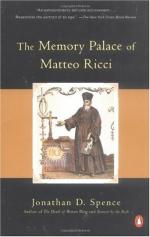|
This section contains 748 words (approx. 2 pages at 400 words per page) |

|
Chapter Four, The Second Image: The Huihui Summary and Analysis
The second example of constructing a memory image is the Chinese ideograph yao. Ricci chooses an ideograph easy to write but difficult to translate. It can mean to want something, to need something, something important or that something must be done. The ideograph is largely contextual in meaning. Yao is used for "shall" in Ricci's translation of the Ten Commandments in 1584. However, when he translates some devotional prayers, he uses yao to mean "fundamental." Again, Ricci cuts the ideograph in two (this time horizontally), the upper meaning "west" and the lower meaning "a woman." A Chinese person would initially understand the split ideograph to mean "a woman from the Xixia territories, who is a Muslim." Ricci prefers to translate it as "a woman from the northwest, who is a...
(read more from the Chapter Four, The Second Image: The Huihui Summary)
|
This section contains 748 words (approx. 2 pages at 400 words per page) |

|




